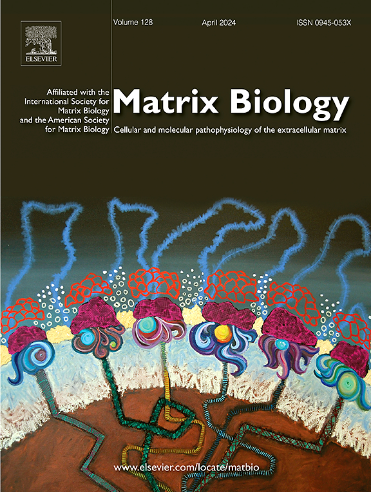Oligomerisation of pentraxin-3: Insights from cryoEM
IF 4.5
1区 生物学
Q1 BIOCHEMISTRY & MOLECULAR BIOLOGY
引用次数: 0
Abstract
Pentraxin-3 (PTX3) is a secreted protein with roles in the stabilisation of hyaluronan-rich extracellular matrices involved in reproductive biology and inflammatory processes, as well as additional functions in innate immunity and cancer. Our recent structural studies (Shah et al., 2025; DOI:10.1016/j.matbio.2025.01.002), involving X-ray crystallography, cryo-electron microscopy (cryoEM) and AlphaFold modelling, have provided clues as to how PTX3 becomes assembled into an octamer from eight identical protomer subunits. Here it was proposed that four protomers initially form a tetramer, composed of a highly extended N-terminal region consisting of coiled-coil structures and C-terminal pentraxin domains, where two tetramers then immediately align and associate via an extensive network of salt bridges, allowing stabilisation of the octamer via the formation of disulphide bonds. However, a paper published around the same time provides an alternative perspective (Guo et al., 2025; DOI: 10.1016/j.ijbiomac.2024.139207). The authors propose, based on cryoEM analyses, that in addition to octamers, stable dimers, tetramers and hexamers of PTX3 can also assemble, where it is the dimers that provide the ‘building blocks’ for generation of the various oligomeric forms. In this commentary we suggest that the presence of dimers, tetramers and hexamers is likely an artefact of the construct used in recombinant expression, since the existence of these oligomers is not consistent with other studies on PTX3. We also provide a model to clarify how protomers become assembled into an octamer via sequential formation of a disulphide-linked tetramer, non-covalent association of two tetramers through aligned ionic interactions and the formation of disulphide bonds between the C-terminal pentraxin domains.
五胜肽-3的寡聚化:低温电子显微镜的启示。
penttraxin -3 (PTX3)是一种分泌蛋白,在稳定富含透明质酸的细胞外基质中发挥作用,参与生殖生物学和炎症过程,以及在先天免疫和癌症中发挥额外功能。我们最近的结构研究(Shah et al., 2025;DOI:10.1016/j.matbio.2025.01.002),涉及x射线晶体学,低温电子显微镜(cryoEM)和AlphaFold建模,提供了关于PTX3如何从八个相同的原聚体亚基组装成八聚体的线索。本文提出,四个原聚体最初形成一个四聚体,由一个高度延伸的n端区域组成,该区域由卷曲的线圈结构和c端戊烷素结构域组成,其中两个四聚体随后通过广泛的盐桥网络立即对齐并结合,从而通过形成二硫键来稳定八聚体。然而,大约在同一时间发表的一篇论文提供了另一种观点(Guo et al., 2025;DOI: 10.1016 / j.ijbiomac.2024.139207)。基于低温电镜分析,作者提出,除了八聚体外,PTX3的稳定二聚体、四聚体和六聚体也可以组装,其中二聚体为生成各种低聚体形式提供了“构建块”。在这篇评论中,我们认为二聚体、四聚体和六聚体的存在可能是重组表达中使用的结构的人工产物,因为这些低聚物的存在与其他关于PTX3的研究不一致。我们还提供了一个模型来阐明原聚体是如何通过二硫化物连接的四聚体的顺序形成、两个四聚体通过排列的离子相互作用的非共价结合以及在c端戊烷素结构域之间形成二硫化物键而组装成八聚体的。
本文章由计算机程序翻译,如有差异,请以英文原文为准。
求助全文
约1分钟内获得全文
求助全文
来源期刊

Matrix Biology
生物-生化与分子生物学
CiteScore
11.40
自引率
4.30%
发文量
77
审稿时长
45 days
期刊介绍:
Matrix Biology (established in 1980 as Collagen and Related Research) is a cutting-edge journal that is devoted to publishing the latest results in matrix biology research. We welcome articles that reside at the nexus of understanding the cellular and molecular pathophysiology of the extracellular matrix. Matrix Biology focusses on solving elusive questions, opening new avenues of thought and discovery, and challenging longstanding biological paradigms.
 求助内容:
求助内容: 应助结果提醒方式:
应助结果提醒方式:


